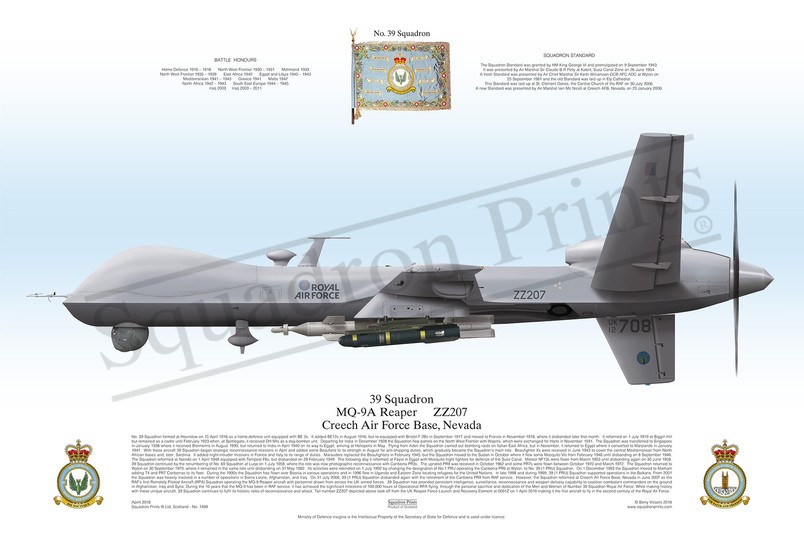#1489 MQ-9A Reaper

Purchased products will not feature the Squadron Prints watermark
Description
Squadron Prints Lithograph No. 1489 - ZZ207, MQ-9A Reaper, 39 Squadron, Creech Air Force Base, Nevada.
No. 39 Squadron formed at Hounslow on 15 April 1916 as a home-defence unit equipped with BE 2s. It added BE12s in August 1916, but re-equipped with Bristol F 2Bs in September 1917 and moved to France in November 1918, where it disbanded later that month. It reformed on 1 July 1919 at Biggin Hill but remained as a cadre until February 1923 when, at Spittlegate, it received DH 9As as a day-bomber unit. Departing for India in December 1928 the Squadron flew patrols on the North West Frontier with Wapitis, which were exchanged for Harts in November 1931. The Squadron was transferred to Singapore in January 1938 where it received Blenheims in August 1939, but returned to India in April 1940 on its way to Egypt, arriving at Heliopolis in May. Flying from Aden the Squadron carried out bombing raids on Italian East Africa, but in November, it returned to Egypt where it converted to Marylands in January 1941. With these aircraft 39 Squadron began strategic reconnaissance missions in April and added some Beauforts to its strength in August for anti-shipping duties, which gradually became the Squadron’s main role. Beaufighter Xs were received in June 1943 to cover the central Mediterranean from North African bases and, later, Sardinia. It added night-intruder missions in France and Italy to its range of duties. Marauders replaced the Beaufighters in February 1945, but the Squadron moved to the Sudan in October where it flew some Mosquito VIs from February 1946 until disbanding on 8 September 1946. The Squadron reformed at Nairobi on 1 April 1948 equipped with Tempest F6s, but disbanded on 28 February 1949. The following day it reformed at Fayid in Egypt with Mosquito night fighters for defence of the Suez Canal. Meteor NF13s were flown from March 1953 until disbanding again on 30 June 1958. 39 Squadron continued by the renumbering of No. 69 Squadron at Luqa on 1 July 1958, where the role was now photographic reconnaissance with Canberra PR3s. The uprated PR9 was received in October 1962 and some PR7s were flown between October 1970 and March 1972. The Squadron returned to Wyton on 30 September 1970, where it remained in the same role until disbanding on 31 May 1982. Its activities were rekindled on 1 July 1992 by changing the designation of No.1 PRU operating the Canberra PR9 at Wyton, to No. 39 (1 PRU) Squadron. On 1 December 1993 the Squadron moved to Marham adding T4 and PR7 Canberras to its fleet. During the 1990s the Squadron has flown over Bosnia in various operations and in 1996 flew in Uganda and Eastern Zaire locating refugees for the United Nations. In late 1998 and during 1999, 39 (1 PRU) Squadron supported operations in the Balkans. From 2001 the Squadron was heavily involved in a number of operations in Sierra Leone, Afghanistan, and Iraq. On 31 July 2006, 39 (1 PRU) Squadron disbanded again with the retirement of the Canberra PR9 from RAF service. However, the Squadron reformed at Creech Air Force Base, Nevada in June 2007 as the RAF’s first Remotely Piloted Aircraft (RPA) Squadron operating the MQ-9 Reaper aircraft with personnel drawn from across the UK armed forces. 39 Squadron has provided persistent intelligence, surveillance, reconnaissance and weapon delivery capability to coalition combatant commanders on the ground in Afghanistan, Iraq and Syria. During the 10 years that the MQ-9 has been in RAF service, it has achieved the significant milestone of 100,000 hours of Operational RPA flying, through the personal sacrifice and dedication of the Men and Women of Number 39 Squadron Royal Air Force. While making history with these unique aircraft, 39 Squadron continues to fulfil its historic roles of reconnaissance and attack. Tail number ZZ207 depicted above took off from the UK Reaper Force Launch and Recovery Element at 0001Z on 1 April 2018 making it the first aircraft to fly in the second century of the Royal Air Force.
You may also like
-
6 Squadron Triple Phantom Jaguar Typhoon
XX112 'EA'; XV432 'N'; ZK342 'ED'6 SqnRAF Leuchars
